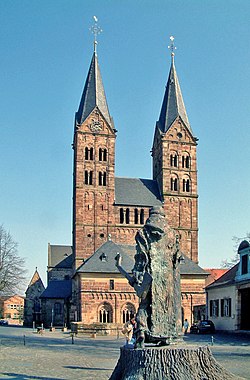Current church
The current church was started around 1085/90 as a High Romanesque basilica. It was likely finished in 1118. [1]
Between 1171 and 1232 a late Romanesque renovation followed. The roof truss above the choir was finished in 1194. The next stage of work already took place in the transitional period from the Romanesque to the Gothic: Between 1253 and 1276, the narthex also known as Paradies, was added. The two fully Gothic southern side aisles date to 1290 to 1323. The Gothic Marienkapelle was constructed in 1354-65/6. [1]
The (half-timbered) chapter hall was built on top of the northeastern crypt around 1560. The rood screen was replaced by a wrought-iron lattice in 1692. A simplified, low-ceilinged upper floor was added to the narthex in 1731, a porch was constructed at the northern portal in 1735. From 1799 to 1828 the high central tower was demolished and replaced by a lower pyramidical tower. [1] [2]
In 1868, a storm caused the southern tower spire to collapse during a mass, killing 21 and injuring 31 people. The spires and pediments of both western towers were then rebuilt around 1873 in Romanesque Revival style. [1]
Comprehensive renovation/repairs occurred in 1913-20 and 1963-70. In 1974, the church museum was opened. [1]
In 2004, Pope John Paul II made the church a Minor Basilica. Another renovation of the church interior took place 2010-12. In December 2012 it was reopened to the public. [1]


